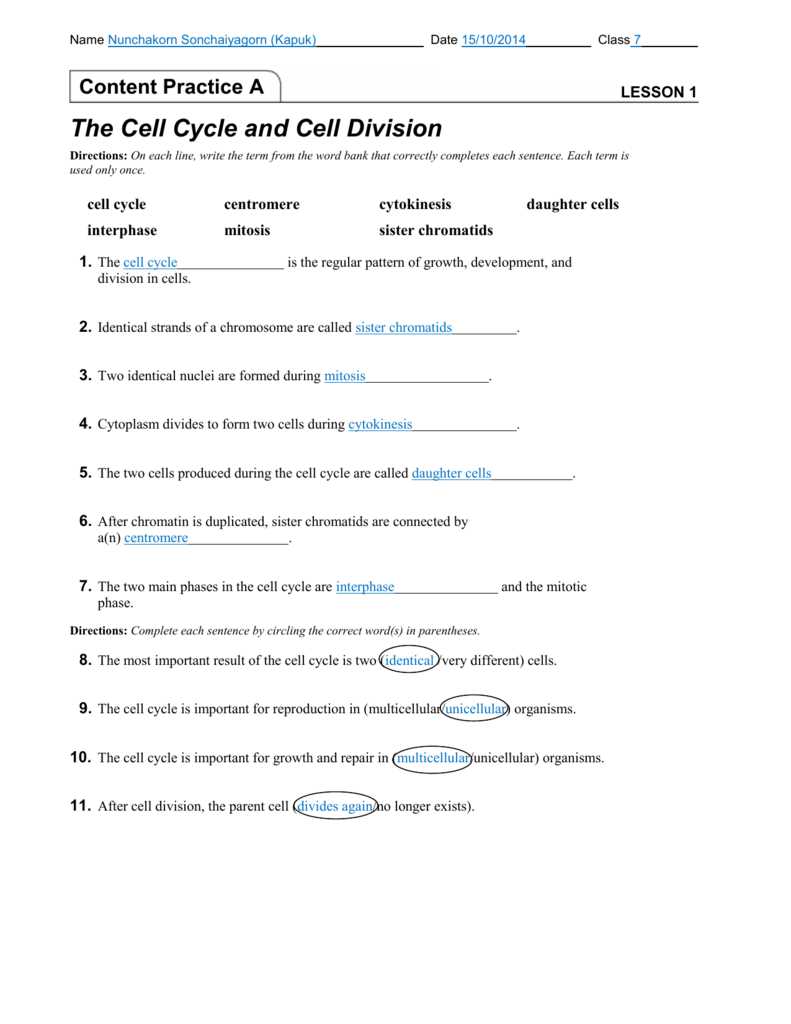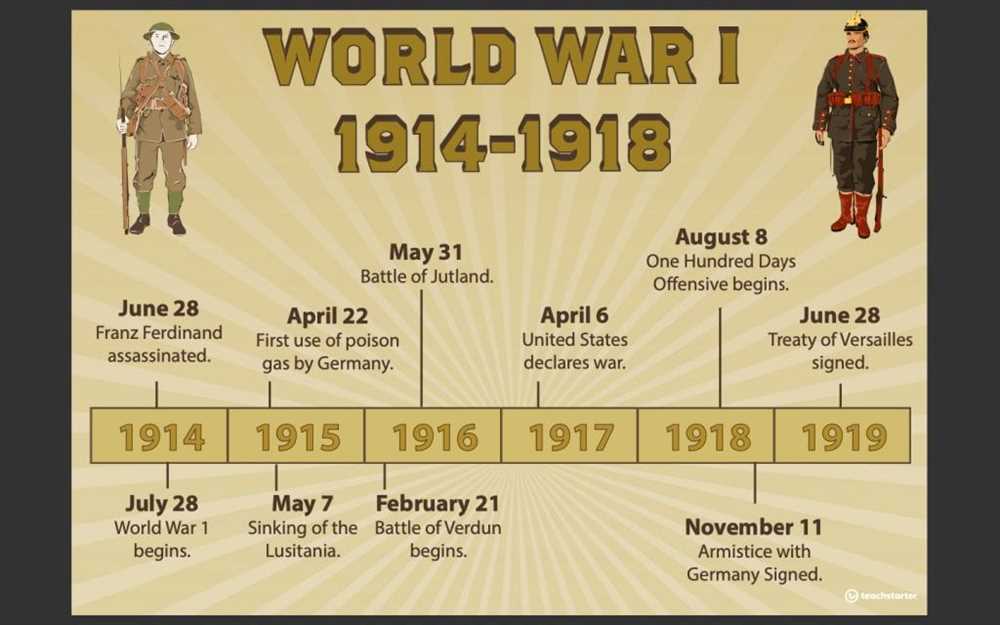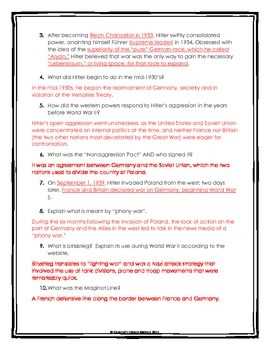
The First World War was a global conflict that lasted from 1914 to 1918 and resulted in profound changes in the political, social, and economic landscape of the world. This webquest answer key will provide you with the essential information to understand the key events and individuals that shaped this monumental war.
One of the prominent causes of World War 1 was the system of alliances that had formed between various European nations. These alliances were intended to provide security and stability, but they ultimately led to the rapid escalation of the conflict. The Triple Entente, consisting of France, Russia, and the United Kingdom, faced off against the Central Powers, which included Germany, Austria-Hungary, and the Ottoman Empire. Tensions ran high, and when the assassination of Archduke Franz Ferdinand of Austria-Hungary occurred in June 1914, it served as the trigger for the outbreak of war.
The military strategies employed during World War 1 were characterized by trench warfare and the use of new technological advancements. The introduction of machine guns, tanks, and chemical weapons brought unprecedented levels of destruction to the battlefield. The war saw millions of soldiers sent to fight and die in horrific conditions, often with little progress being made on either side.
The aftermath of World War 1 saw the collapse of several empires, the redrawing of national borders, and the establishment of the League of Nations as a means of preventing future conflicts. The war had a far-reaching impact on societies around the world, leading to political and social upheaval and setting the stage for future conflicts, including World War 2. Understanding the key events and factors that shaped World War 1 is crucial to comprehending the complex history that followed.
Exploring the Causes of World War 1

The causes of World War 1 are complex and multifaceted. They can be categorized into four main factors: militarism, alliances, imperialism, and nationalism. Each of these factors played a significant role in escalating tensions and ultimately leading to the outbreak of the war.
Militarism

Militarism refers to the glorification of military power and the buildup of armed forces. In the late 19th and early 20th centuries, European powers engaged in a race to build larger and more advanced armies and navies. This arms race created a sense of fear and competition among nations, fuelling the desire for military dominance. Furthermore, the development of new weapons and technologies, such as machine guns and submarines, increased the potential destructiveness of war.
Alliances
The second major cause of World War 1 was the system of alliances that existed among European powers. These alliances were formed through a series of treaties and agreements, creating a tangled web of obligations. The two main alliance systems were the Triple Entente (consisting of Britain, France, and Russia) and the Central Powers (including Germany, Austria-Hungary, and Italy). These alliances were meant to provide security and deter aggression, but instead, they created a domino effect, drawing countries into conflict when one member was attacked.
Imperialism

Imperialism, the economic and political domination of one country over others, was another significant cause of World War 1. European powers competed for colonies and territories around the world, as these colonies provided resources and markets for trade. The scramble for colonies increased tensions among nations, as they sought to expand their empires and protect their interests. The competition for colonies also intensified rivalries and rivalries between European powers, exacerbating existing tensions.
Nationalism
Nationalism, the belief in the superiority of one’s own nation, also played a crucial role in fueling the conflict. In the late 19th and early 20th centuries, nationalism was on the rise in Europe. Various ethnic and national groups sought self-determination and independence, leading to conflicts within existing empires. The desire for national self-determination and the protection of national interests often clashed with the interests of other nations, creating a volatile and tense international environment.
In conclusion, the causes of World War 1 were a complex interplay of militarism, alliances, imperialism, and nationalism. These factors created a volatile and tense international environment, ultimately leading to the outbreak of the war. Understanding these causes is crucial in order to prevent similar conflicts in the future and strive for peaceful resolutions of disputes.
Understanding the Major Players in World War 1
The First World War involved a number of major players, each with their own political, economic, and military interests. These players had a significant impact on the events leading up to the war and on its outcome. Understanding the major players is key to understanding the complexities of this global conflict.
Allied Powers
The Allied Powers, also known as the Entente Powers, were the countries that fought against the Central Powers in World War 1. The major players in the Allied Powers included Great Britain, France, and Russia. Great Britain was one of the most powerful nations in the world at the time and had a vast colonial empire. France had a long-standing rivalry with Germany and had lost territories to them in previous conflicts. Russia, despite its internal political turmoil, was a major military power and provided a significant number of troops to the war effort. Other countries later joined the Allies, including Italy, Japan, and the United States.
Central Powers

The Central Powers were the countries that opposed the Allied Powers in World War 1. The major players in the Central Powers included Germany, Austria-Hungary, and the Ottoman Empire. Germany, under the leadership of Kaiser Wilhelm II, was a rising power and had ambitions for territorial expansion. Austria-Hungary was a multinational empire facing internal unrest. The Ottoman Empire, although in decline, still controlled significant territories in the Middle East. Bulgaria and the Kingdom of Bulgaria also joined the Central Powers later in the war.
Other Major Players
There were other major players in World War 1 that had significant influence on the course of the war. The United States, although initially neutral, eventually joined the Allied Powers and became a crucial factor in securing victory. Italy, originally part of the Central Powers, switched sides in 1915 and joined the Allies. Japan, a major power in the Pacific, also joined the Allies to gain territory and influence. Serbia, a small country in the Balkans, played a key role in the war as it was the target of Austria-Hungary’s initial attack.
Understanding the major players in World War 1 helps to shed light on the complex interactions and alliances that shaped this global conflict. Each country had its own motivations and interests, which ultimately determined their actions during the war. The war forever changed the geopolitical landscape and set the stage for future conflicts and alliances.
World War 1 Webquest Answer Key: The Outbreak of the War
The outbreak of World War 1 was a global conflict that began on July 28, 1914, and lasted until November 11, 1918. It was triggered by the assassination of Archduke Franz Ferdinand of Austria-Hungary by a Serbian nationalist. This event set off a chain reaction of alliances and conflicts among the major powers of Europe, ultimately leading to the outbreak of war.
One of the main causes of World War 1 was the system of alliances that had developed in Europe. These alliances, such as the Triple Entente and the Central Powers, created a complex network of obligations and commitments that pulled countries into the war. When Austria-Hungary declared war on Serbia, Russia, an ally of Serbia, mobilized its forces. This led to Germany declaring war on Russia and its ally France. The conflict quickly spread as more countries entered the war on both sides.
The key events leading to the outbreak of World War 1 included:
- The assassination of Archduke Franz Ferdinand
- Austria-Hungary’s ultimatum to Serbia
- Russia’s mobilization and Germany’s declaration of war
- The invasion of Belgium by Germany
- The declaration of war by Britain and its allies
The outbreak of World War 1 had significant consequences for the countries involved and the world as a whole. It resulted in the deaths of millions of soldiers and civilians, the destruction of cities and infrastructure, and political and social upheaval. The war also laid the groundwork for future conflicts and shaped the geopolitical landscape of the 20th century.
Identifying the Assassination of Archduke Franz Ferdinand
The assassination of Archduke Franz Ferdinand, the heir to the Austro-Hungarian throne, was a significant event that sparked the beginning of World War I. On June 28, 1914, Ferdinand and his wife Sophie were visiting Sarajevo, Bosnia, when they were targeted by a group of assassins.
The assassination plot was organized by a secret society known as the Black Hand. The group aimed to free Bosnia from Austro-Hungarian rule and unite it with Serbia. Gavrilo Princip, a member of the Black Hand, shot and killed Ferdinand and Sophie during their visit. Their deaths served as the catalyst for a chain of events that led to the outbreak of war.
The assassination carried a great political significance. It undermined the already fragile relations between Austria-Hungary and Serbia and created a climate of tension in Europe. Austria-Hungary saw the assassination as an act of aggression by Serbia and demanded a full investigation and punishment of those responsible. When Serbia failed to comply with Austria-Hungary’s demands, the situation escalated and led to a series of ultimatums, declarations of war, and the formation of military alliances.
The assassination of Archduke Franz Ferdinand not only set off a chain reaction of events but also highlighted the underlying political and nationalistic tensions in Europe at the time. It exposed the weaknesses of the European alliances and the complexities of the geopolitical landscape. Ultimately, it led to the mobilization of troops, the declaration of war, and the loss of millions of lives during World War I.
| Name | Role |
|---|---|
| Gavrilo Princip | Assassin |
| Archduke Franz Ferdinand | Target of the assassination |
| Sophie, Duchess of Hohenberg | Archduke’s wife |
| The Black Hand | Secret society behind the plot |
In conclusion, the assassination of Archduke Franz Ferdinand was a pivotal event that set the stage for the outbreak of World War I. It exposed the underlying tensions and complexities of the geopolitical landscape in Europe and led to a series of political and military actions that ultimately resulted in one of the deadliest conflicts in history.
Examining the Alliance System
The alliance system played a significant role in the outbreak of World War I. Prior to the war, European powers had established a complex network of alliances in an effort to maintain a balance of power and deter potential aggressors. These alliances were primarily defensive in nature, with the intention of providing mutual support and protection in the event of an attack.
One of the key alliances was the Triple Entente, consisting of France, Russia, and the United Kingdom. This alliance formed in response to the growing power of Germany and the Central Powers. The Triple Entente aimed to contain the expansionist ambitions of Germany and maintain the status quo in Europe.
Another significant alliance was the Triple Alliance, which consisted of Germany, Austria-Hungary, and Italy. This alliance emerged in response to the formation of the Triple Entente and aimed to counterbalance its influence. The Triple Alliance sought to protect the interests of its member states and prevent any potential aggression from the Triple Entente.
- The Triple Entente:
- France
- Russia
- United Kingdom
- The Triple Alliance:
- Germany
- Austria-Hungary
- Italy
These alliances created a complex web of relationships among the European powers, making it difficult to contain conflicts and prevent their escalation. When the assassination of Archduke Franz Ferdinand of Austria-Hungary in 1914 sparked a chain reaction of events, the alliance system came into play. Austria-Hungary invoked its alliance with Germany, while Russia mobilized in support of its ally, Serbia. Soon, other countries were drawn into the conflict, leading to the outbreak of World War I.
The alliance system not only intensified the scale and scope of the war but also contributed to its prolonged duration. The rigid nature of the alliances meant that once a country entered the conflict, its allies were obligated to provide support, leading to a domino effect of declarations of war. This interlocking system of alliances turned a regional conflict into a globalized war, with devastating consequences for millions of people.
World War 1 Webquest Answer Key: The Trench Warfare
In World War 1, trench warfare was a common form of warfare that defined the conflict. Trenches were long, narrow ditches dug into the ground for soldiers to seek shelter and protection from enemy fire. The trenches were typically several feet deep and wide enough for soldiers to move around. Trenches were often zigzagged to minimize the impact of an enemy attack.
Trench warfare was characterized by its harsh and difficult conditions. Soldiers living in the trenches had to endure constant exposure to the elements, including rain, snow, and extreme temperatures. The trenches were often filled with mud, water, and rats, which caused numerous health problems for the soldiers. Additionally, the trenches were infested with lice, leading to the spread of diseases like trench fever.
The purpose of trench warfare was to provide soldiers with a defensive position from which they could fire upon the enemy. Soldiers would take turns being on the front line and would rotate back to the rear for rest. The front line soldiers were constantly under the threat of enemy attacks and sniper fire. Trench warfare was characterized by its static nature, with neither side able to make significant advances without suffering heavy casualties.
Communication and supply lines were essential for soldiers in the trenches. Soldiers used a complex system of messengers and telephone lines to communicate with commanders and receive orders. Supplies such as food, water, and ammunition were brought to the trenches through a network of supply lines, often under dangerous conditions.
Trench warfare played a significant role in World War 1 and had a lasting impact on military strategy. The conditions in the trenches and the high casualty rates led to a sense of disillusionment among soldiers and contributed to the development of new tactics and technologies. Overall, the trench warfare of World War 1 was a brutal and challenging aspect of the conflict.